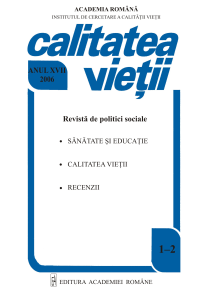Probleme ale transformării scalelor de satisfacţie faţă de viaţă
Abstract
Life satisfaction, a global cognitive evaluation of one’s life, is a very frequently used indicator in quality of life research. This construct is usually measured by simple scales, differing one from another by the phrasing of questions and by the number of answer categories. Giving the need for international comparison of levels of subjective well-being, international comparative programs were initiated that contains surveys conducted almost simultaneously, with the same methodology. These surveys are very expensive and cannot be conducted as frequently as needed. An alternative is the homogenization of survey data from different national level programs. The main impediment is the variation in the length of the scales, those with 3, 4, 5, 7 or 11 categories being most frequently used. This brings the need for testing procedures for transformation of these scales. The objective of this paper is to review the methodological backgrounds of such a process, highlighting the signification and possible errors induced by the attributions of scores to the categories of ordinal-level variables. We propose an exercise of transforming an ordinal scale with 5 categories, used in Diagnosis of Quality of Life research program organized by Romanian Institute for Quality of Life to an 11-scale pseudo-interval scale, frequently used in international research programs. Several translation strategies are presented from the simplest, i.e. conventional linear transformation, to the most sophisticated-like estimation from the observed frequencies and distributional assumption, transformation by expert ratings and regression with optimal scaling. Finally, methods are comparatively evaluated and recommendations for researchers are formulated.
Downloads
Published
How to Cite
Issue
Section
Copyright (c) 2006 Romanian Academy Publishing House

This work is licensed under a Creative Commons Attribution 4.0 International License.





